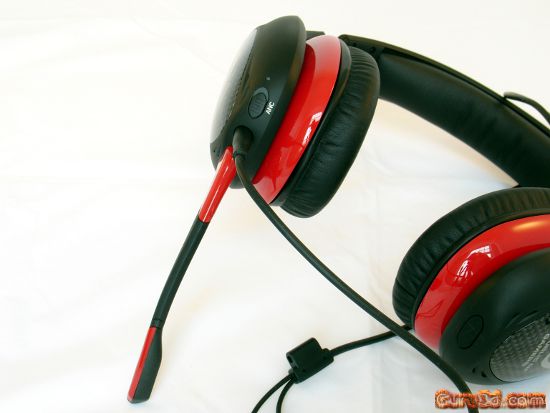Page 3 - Specification
Specification
The Vulcan ANC is a sealed back design that ASUS calls passive noise canceling, but it's a fancy term for simple sound isolation. Any sealed back headphone offer some kind of noise isolation, and certainly in-ear types, like Etymotic or Sure, offer the best isolation. Of course, not everybody likes to wear the in-ear headphones, so ANC headphones offer more comfort and style. The only other ANC headphones I can think of are the much more expensive Bose QuietComfort. Open-ear headphones, like Grado or Sennheiser, offer the best sound for the money, but really don't have any sound isolation. In fact, open-ear headphones actually contribute to noise, which I will test the Vulcan ANC against.
Anyway, the Vulcan earcups are built around 40mm drivers fitted to a folding headband of soft leatherette. The main problem of sealed-back designed headphones is that they tend to sound like the material they're made from. In this case, plastic. Tapping on the red earcups of the Vulcan produces a solid tick-tick sound.
There are some chrome accented plastic parts on the headband. I think if you're going to use chrome, just chrome the whole thing, so I can get my Cylon-geek on. Nope, I am not going to give you a single Start Trek joke here.
Aside from the chrome accents, the black and red design is very well done and exudes a nice macho feeling.
Specifications
- Driver: 40mm
- Impedance: 32 Ohm
- Frequency range: 10~20 KHz
- ANC (active noise cancellation) performance: Maximum >15dB
- Effective Bandwidth >600 Hz
- PNC (passive noise cancellation) performance: Maximum >30dB
- Battery life: Up to 40 hours (with one AAA battery)
- Dimension: 206mm x 196mm x 80mm (LxWxH)
- Weight: 325g
The Vulcan does have a few parts that you have to put together before you get all the features out of it. I'm sure you've spotted the big one already, the AAA battery. Active noise cancellation doesn't come free, unfortunately. But you will get a week of 8 hour gaming days out of a single battery. The Vulcan has a decent amount of passive isolation already, so even if the battery goes flat, you'll still get very good isolation performance.
Speaking of which, you get a maximum of 30dB of isolation with the ANC. You can download an app for your smartphone to measure the noise of your environment, but noise around 50 to 60dB is about average. On top of that, the Vulcan can drop noise to around 35dB, which is very quiet. For comparison, normal conversation is around 60dB, a loud motorcycle is about 90dB, a good rock concert is about 100dB, and a jet taking off is about 120dB.
Impedance is an easy-to-drive 32 Ohm, which makes it easy enough to get loud with just the onboard sound. We used the Vulcan with an external DAC/AMP combo with great success.
The frequency range is 10 Hz to 20 KHz, which is pretty wide. Most, if not all, headphones don't have enough oomph to really give your head a good shake below 20 Hz. What I mean by this is that at that frequency, 10 Hzto 20 Hz, it's a massage more than any audible sound you could hear, and with a 40mm driver, that's just not going to produce enough pressure for you to feel it. I can say that with our Stereophile test CD, the Vulcan did play lower than our reference headphones.
Using our kitchen scale, the Vulcan ANC comes in at 351g without battery or microphone, about 25g heavier than specified. Fully loaded with cable, battery, and mic the scale read 375g. The AKG K701 are 370g on the same scale, so the Vulcan doesn't quite disappear on your head, but it does a pretty good job of not breaking your skull either. It's very comfortable, something you should not overlook if you do any kind of long gaming sessions or just at your computer, uh, not looking at pr0n or listening to music.

